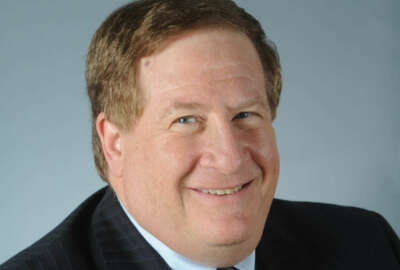Hubbard Radio Washington DC, LLC. All rights reserved. This website is not intended for users located within the European Economic Area.
Contractors worry first about getting the contract and second, can they fulfill it
People running federal contractors must forecast their annual business, no less than any other CEO. What makes the federal market unique is that the specific si...
People running federal contractors must forecast their annual business, no less than any other CEO. What makes the federal market unique is that the specific size is known year after year. IT services company Unanet and the law firm Cohn Reznick asked contractors about their biggest challenges. To hear about the results, Federal Drive with Tom Temin spoke with Kim Koster, Unanet vice president.
Interview Transcript:
Tom Temin This is something you’ve done for several years now, is to kind of take the pulse of the contractor industry.
Kim Koster Absolutely. Christine Williamson from Cohn Reznick and I started doing this in 2017. That would have been our maiden voyage into the gauge.
Tom Temin And aside from whether people are optimistic or not optimistic, they have specific challenges that turn up in the survey. And given the uncertain appropriations situation, which is somewhat separate from the spending situation, because even if there’s no appropriations and they go to a CR, they’re spending, what are contractors worried about going into the end of ’23 and going into ’24?
Kim Koster Well, we continue to have contractors worried about recruiting and retention that’s been going on now for several years. But the biggest project management challenge that we’ve seen out of the marketplace is really forecasting resources. So to me, that becomes really the biggest challenge that our contractors are having.
Tom Temin What is it they’re trying to forecast?
Kim Koster They’re trying to really see when they need those resources, when those resources need to start work, what skill set those resources need to be. And making sure that HR and the folks that are recruiting have the ability to place those people on those projects so that those projects become on time and on budget.
Tom Temin Right. So the talent acquisition problem becomes, really that’s the resource that they’re worried about.
Kim Koster That’s correct.
Tom Temin If you’re a hardware reseller, then you just get the hardware you need as you need it, and you order it and resell it. But in the case of putting people on a job, that’s a little subtler of a problem isn’t it?
Kim Koster It is. And Tom, it really all starts back with pipeline forecasting. We did a deep dive this year on forecasting, and we did it in eight different areas. And one of the most interesting things that came out of this was that pipeline forecasting was very important, yet it didn’t have the accuracy of all the other forecasts. And that pipeline forecast is telling us what resources we’re going to need in the future, what projects we’re going to get. So as a growth engine, the pipeline is tremendously important, and it really shows the trajectory overall of your business.
Tom Temin Right. You even have a formula for it. Measure of metric you’ve devised, probability of wins, times the probability of actually going ahead with it, equals the probability of award. So you have to know what you’re going to win. And that begins with what should I bid on? So tell us more about that formula.
Kim Koster If you’re looking at what you’re going to bid on, you’re going to be able to see, Hey, what are my differentiators? What makes me better than Company A, B or C? So what is the probability that I’m going to get that contract, that I’m going to win that bid? And then the probability of a go is whether or not the federal government is actually going to fund it. So when I put those two together, I’m able to get a probability of award. And then that’s going to provide a factor for me to do all of my revenue forecasting out in the future.
Tom Temin Well, the probability of win presumes that there is a totally objective process on the part of the government that you can predict that if A, B, and C happens, because we’re better than them on those things, boom, we’ll get it. But it doesn’t work out that way sometimes.
Kim Koster But that is your best guess internally. So it’s your people really taking an honest look at where your company is, compared to your competitors. And I think that’s really important, that people really do look inward to their own capabilities and their abilities to get those resources and understand what’s out there.
Tom Temin Right. In other words, you can get much closer to the hole with your golf ball from the tee. If you do a little bit of analytics of yourself, you’re not going to get a hole in one, but you can come a lot closer to a decent put chance.
Kim Koster That’s correct.
Tom Temin We’re speaking with Kim Koster, she’s a vice president at Unanet. The implication is that maybe companies don’t do this as systematically as they should. Do you have any recommendations on how do you systematically look at your strengths and your opportunities? What is it called, SWAT type of analysis, I think is kind of what we’re talking about here that the contractors could use to get better at it.
Kim Koster One thing that we did note in the survey was that the capture process, a lot of the smaller companies didn’t really have a capsule process. And I think that as part of that process, the pursuit process, that people should look objectively at the competition. So I think honestly, it just becomes a part of that overall pursuit discipline that should be going on before we actually even except that opportunity into our system.
Tom Temin And there’s kind of a timing question here, too. Because if you do win, and then you need to start executing on something that has been funded, and you knew what your human resource requirements were, then you have to get that requirement filled. And that gets back to the difficulty of hiring, onboarding, maybe initially finding the right people, except by maybe poaching them from the people that didn’t win.
Kim Koster Right. And I think that’s one of the important things about really being able to hone in on that forecast. And that probability of award may change over time as we get nearer to award. Now, you may have all indications that you’re going to get that contract. And you have a little higher probability to let your HR team know to go off and hire the skills that you need or the people that you need.
Tom Temin And you find that, again, the survey probably gives you some indication of who’s answering. Are the large firms necessarily better at this than the smaller contractors?
Kim Koster I’ll tell you, definitely the larger firms are better. They’re going to have a more disciplined process up front. They’re going to have a capture process. And so they’re going to be much better at it.
Tom Temin In fact, sometimes the big ones will just acquire who they think will give them that advantage.
Kim Koster That’s a possibility, too. We did see that there is quite a bit of M&A opportunity and action going on out there this year.
Tom Temin Are there any exigent circumstances right now, post-pandemic and given the weird political situation the country is in and so on, that over the seven years you’ve been doing the survey have emerged. What’s new, maybe looking ahead into ’24 that you might not have seen before?
Kim Koster Well, one thing that started in 2022 was we really saw a resurgence of taking [Defense Contract Audit Agency (DCAA)], looking at business systems. So there’s six business systems, and they really came in and started taking a hard look at that. In fact, Director Dilly inside the report to Congress mentions that 288 of those business systems audits were completed in 2022. So I look for more of those. We also started to see a trend towards more accounting system audits in solicitations. So, do you have an improved accounting system? That’s becoming more and more criteria for winning new business.
Tom Temin And we’re speaking about the Defense Contract Audit Agency. That’s pretty much sort of a side factor in here that can blow in at any time, then, can it?
Kim Koster Yes. And so I think that’s been a really big trend. We’ve seen a lot of people now focusing on other areas of business like earned value, purchasing, estimating. But still, the accounting audit is definitely still the biggest one to be concerned about in the most significant for getting points on a solicitation.
Tom Temin And what about Labor Department and White House requirements? I’m thinking of reporting and information data gathering by the Office of Federal Contractor Compliance Programs at the Labor Department. Climate reporting requirements they keep getting layered on. Do you think that’s an emerging trend that makes people say, well, why should I bother with federal business?
Kim Koster Well, the one thing the federal business does is it provides a very stable environment. And Christine and I were talking the other day and we said the one thing that this report does is there are very complex issues within this federal government contracting space. But the nice thing about it is, if you look year over year, it stays pretty stable. And so that should give people confidence in coming into this market. And there’s great people, the Cohn Reznicks of the world, the Unanets of the world that can help you with that journey. So I think that no matter what is actually happening out there, that the GovCon market is still a very attractive market.
Tom Temin It’s like a trout pond that someone has thrown a whole bushel basket times ten of trout in. You know there’s fish in there. You just got to get your hook down there.
Kim Koster That’s correct. And the one thing about it is it’s not just one vertical. There’s multiple different kinds of things going on in the federal government contracting world all the time. And so whenever your service or your product is, there’s likely a space for you in this business, in this market.
Copyright © 2024 Federal News Network. All rights reserved. This website is not intended for users located within the European Economic Area.
Tom Temin
Tom Temin is host of the Federal Drive and has been providing insight on federal technology and management issues for more than 30 years.
Follow @tteminWFED
Related Stories
Related Topics





